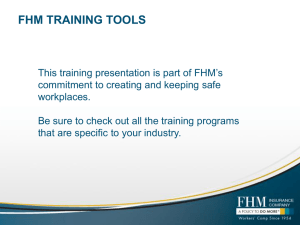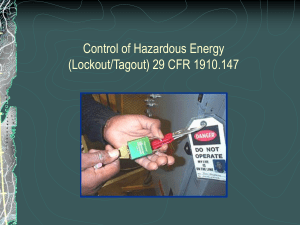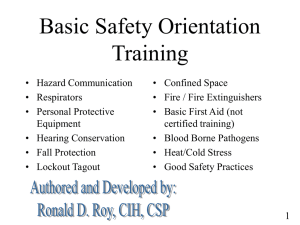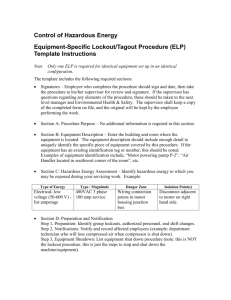A sample lockout/tagout policy for your workplace
advertisement
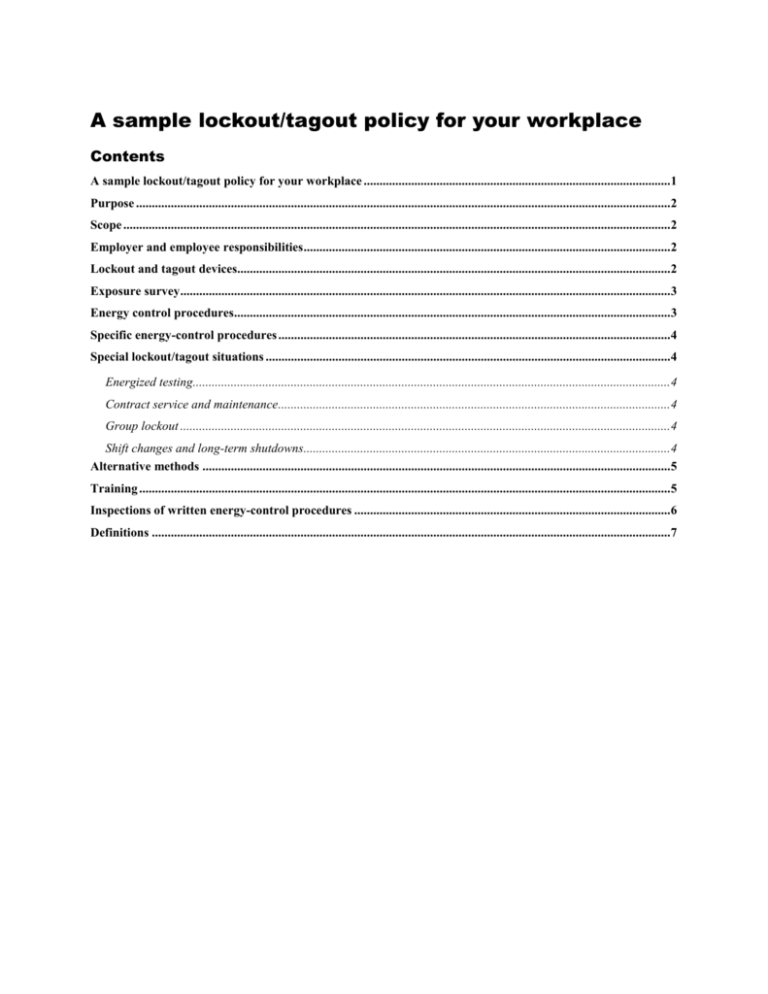
A sample lockout/tagout policy for your workplace Contents A sample lockout/tagout policy for your workplace .................................................................................................1 Purpose .........................................................................................................................................................................2 Scope .............................................................................................................................................................................2 Employer and employee responsibilities ....................................................................................................................2 Lockout and tagout devices.........................................................................................................................................2 Exposure survey ...........................................................................................................................................................3 Energy control procedures..........................................................................................................................................3 Specific energy-control procedures ............................................................................................................................4 Special lockout/tagout situations ................................................................................................................................4 Energized testing.......................................................................................................................................................4 Contract service and maintenance ............................................................................................................................4 Group lockout ...........................................................................................................................................................4 Shift changes and long-term shutdowns....................................................................................................................4 Alternative methods ....................................................................................................................................................5 Training ........................................................................................................................................................................5 Inspections of written energy-control procedures ....................................................................................................6 Definitions ....................................................................................................................................................................7 Purpose This establishes [name of your company] policy for protecting employees who must do service or maintenance on machines or equipment and who could be injured by an unexpected start-up or release of hazardous energy. Service or maintenance includes erecting, installing, constructing, repairing, adjusting, inspecting, unjamming, setting up, trouble-shooting, testing, cleaning, and dismantling machines, equipment or processes. This policy will ensure that machinery or equipment is stopped, isolated from all hazardous energy sources, and properly locked or tagged out. Scope This policy applies to all [name of your company] employees who may be exposed to hazardous energy during service or maintenance work. Uncontrolled energy includes potential, kinetic, flammable, chemical, electrical, and thermal sources. Employer and employee responsibilities [Name of your company] is responsible for implementing and enforcing this policy. All employees must comply with this policy. Supervisors must enforce the use of lockout and tagout devices when employees do service or maintenance work and may be exposed to hazardous energy. Employees who do service and maintenance work must follow the lockout/tagout procedures described in this policy. Employees who work in areas where lockout/tagout procedures are used must understand the purpose of the procedures and are prohibited from attempting to restart machines or equipment that are locked or tagged out. Lockout and tagout devices Lockout and tagout devices must meet the following criteria to ensure that they are effective and not removed inadvertently: Lockout devices must work under the environmental conditions in which they are used. Tagout device warnings must remain legible even when they are used in wet, damp, or corrosive conditions. Lockout and tagout devices must be designated by color, shape, or size. Tagout devices must have a standardized print and warning format. Lockout devices and tagout devices must be strong enough that they can’t be removed inadvertently. Tagout devices must be attached with a single-use, self-locking material such as a nylon cable tie. Any employee who sees a lockout or tagout device must be able to recognize who attached it and its purpose. Each lock must have a unique key or combination. Energy-isolating devices are the primary means for protecting [name of your company] employees who service equipment and must be designed to accept a lockout device. Energy isolating devices must clearly identify function. Electrical energy sources. Lockout or tagout of electrical energy sources must occur at the circuit disconnect switch. Electrical control circuitry does not effectively isolate hazardous energy. See also, Alternative methods. Exposure survey [Employee’s name or job title] will conduct a hazardous-energy survey to determine affected machines and equipment, types and magnitude of energy, and necessary service and maintenance tasks. Each task will be evaluated to determine if it must be accomplished with lockout or tagout procedures. Energy control procedures Authorized employees who lockout or tagout equipment or do service and maintenance must follow specific written energy-control procedures. The procedures must include the following information: The intended use of the procedure Steps for shutting down, isolating, blocking, and securing equipment Steps for placing, removing, and transferring lockout devices Equipment-testing requirements to verify the effectiveness of the energy-control procedures When re-energizing equipment is necessary — when power is needed to test or position the equipment, for example — temporary removal of lockout or tagout devices is allowed. This applies only for the time required to perform the task and the procedure must be documented. Employees must do the following before they begin service or maintenance work: 1. Inform all affected employees of equipment shutdown. 2. Shut down equipment. 3. Isolate or block hazardous energy. 4. Remove any potential (stored) energy. 5. Lockout or tagout the energy sources. 6. Verify the equipment is isolated from hazardous energy and de-energized. Employees must do the following they remove lockout or tagout devices and re-energize equipment: D:\116101771.doc 3 1. Remove tools and replace machine or equipment components. 2. Inform coworkers about energy-control device removal. 3. Ensure all workers are clear of the work area. 4. Verify machine or equipment power controls are off or in a neutral position. 5. Remove the lockout or tagout device. 6. Re-energize equipment. Specific energy-control procedures This company has developed specific energy-isolation procedures for all machines and equipment that have energy-isolating devices. Note to employers: See Example of a specific energy control procedure and Form for documenting a specific energy-control procedure on this CD for help on documenting specific energy-control procedures. Special lockout/tagout situations Energized testing When an energy-isolating device is locked or tagged and it is necessary to test or position equipment, do the following: 1. Remove unnecessary tools and materials. 2. Ensure that all other employees are out of the area. 3. Remove locks or tags from energy isolating devices. 4. Proceed with test. 5. Deenergize equipment and lockout or tagout energy-isolating devices. 6. Operate equipment controls to verify that the equipment is de-energized. Contract service and maintenance [Name of your company] and contractors must be aware of their respective lockout/tagout procedures before the contractor does onsite work. [Name of your company] employees must understand and comply with the contractor’s energy-control procedures. Group lockout When authorized employees must service equipment that has several energy sources and several energy-isolating devices, the employees must follow group lockout procedures. The following machines and equipment require group lockout: [identify the machines and equipment] Shift changes and long-term shutdowns Employees must follow [name of your company] specific written procedures when it is necessary to continue lockout/tagout when work shifts change and during long-term shutdowns. [Name of person, or job title] is responsible for monitoring lockout and tagout devices that control the energy to equipment during long-term shutdowns D:\116101771.doc 4 Alternative methods When lockout or tagout is not used for tasks that are routine, repetitive, and integral to the production process, or prohibits the completion of those tasks, then an alternative method must be used to control hazardous energy. Selection of an alternative control method must be based on a risk assessment of the machine, equipment, or process. The risk assessment must consider existing safeguards provided with the machine, equipment or process that may need to be removed or modified to perform a given task. For example, when control circuits are used as part of the safeguarding system, the system must be designed to ensure protection as effective as a mechanical disconnect switch or master shutoff valve. A control-reliable dual channel hardwired circuit of industrially-rated components that satisfies the design features as specified in ANSI B11.19, with a safety relay or safety PLC to ensure integrity and performance of the safeguarding system, must be used. Under all circumstances, the individual must have exclusive personal control over the means to maintain the state of the control circuit in a protective mode. Training Employees who may be exposed to hazardous energy will receive training before assignment to ensure that they understand [name of your company] energy-control policy and have skills to apply, use, and remove energy controls. The training will include the requirements of 1910.147 and the following: Affected employees will be trained in the purpose and use of energy-control procedures. An affected employee uses equipment that is being serviced under lockout or tagout procedures or works in an area where equipment is being serviced. Authorized employees will be trained to recognize hazardous energy sources, the type and magnitude of energy in the workplace, the methods and means necessary for isolating and controlling energy, and the means to verify that the energy is controlled. An authorized employee locks out or tags out equipment to do service work. An affected employee becomes an authorized employee when that employee’s duties include service or maintenance work on equipment. Employees whose jobs are in areas where energy-control procedures are used will be trained about the procedures and the prohibition against starting machines that are locked or tagged out. Employees will be retrained annually to ensure they understand energy-control policy and procedures. Authorized and affected employees will be retrained whenever their job assignments change, energy-control procedures change, equipment or work processes present new hazards, or when they don’t follow energy-control procedures. Current training records will be maintained for each authorized and affected employee including the employee’s name and the training date D:\116101771.doc 5 Inspections of written energy-control procedures [Name of your company] will perform and document annual inspections of energy-control procedures to ensure that employees understand and use them effectively. Documentation will include the following: The equipment on which the procedure is used. The date of the inspection. The employees included in the inspection. The inspector. If an inspector finds that employees are not following an energy-control procedure or that the procedure is not protecting them, employees must be retrained and the procedure’s deficiencies corrected. The inspector must understand the procedure and must be someone other than those following the procedure at the time of the inspection. Each procedure’s accuracy, completeness, and effectiveness must be verified. If the inspection covers a procedure for equipment with an energy-isolating device that can be locked out, the inspector must review the procedure with the employees who use it to service the equipment. The inspector can review the procedure with the employees individually or in a group. If the inspection covers a procedure for equipment with an energy-isolating device that can only be tagged out, the inspector must review the procedure with the authorized employees who service the equipment and with affected employees who may work in the area when the equipment is serviced. The inspector can review the procedure with the employees individually or in a group. D:\116101771.doc 6 Definitions Affected employee A person who uses equipment that is being serviced under lockout or tagout procedures, or who works in an area where equipment is being serviced. Authorized employee A person who locks out or tags out equipment to do service or maintenance work. An affected employee becomes an authorized employee when that employee’s duties include service or maintenance work on equipment. Capable of being locked out An energy-isolating device that is designed with a hasp or other means of attachment to which, or through which a lock can be affixed, or if it has a locking mechanism built into it. Other energy-isolating devices will also be considered to be capable of being locked out, if lock out can be achieved without the need to dismantle, rebuild, or replace the energy-isolating device or permanently alter its energy-control capability. Disconnect A switch that disconnects an electrical circuit or load (motor, transformer, or panel) from the conductors that supply power to it. An open circuit does not allow electrical current to flow. Under a lockout procedure, a disconnect must be capable of being locked in the open position. Energized Connected to an energy source or containing potential energy. Energy source Any source of energy. Examples: electrical, mechanical, hydraulic, pneumatic, chemical, and thermal. Energy-isolating device A mechanical device that physically prevents transmission or release of energy. Hazardous energy Any of the types of energy existing at a level or quantity that could be harmful to workers or cause injury through inadvertent release or start-up of equipment. Lockout device A device that locks an energy-isolating device in the safe position. Lockout Placing a lockout device on an energy-isolating device, under an established procedure, to ensure the energy-isolating device and the equipment it controls can’t be operated until the lockout device is removed. (An energy-isolating device is capable of being locked out if it has a hasp that accepts a lock or if it has a locking mechanism built into it.) Procedure A series of steps taken to isolate energy and shut down equipment. Servicing or maintenance Workplace activities such as constructing, installing, setting up, adjusting, inspecting, modifying, and maintaining machines or equipment. Also includes lubricating, cleaning, unjamming, and making adjustments or tool changes if a worker may be exposed to the unexpected startup of the equipment during such activities. Tagout device A prominent warning sign, such as a tag, that can be securely fastened to an energy-isolating device to indicate that the energy-isolating device and the equipment it controls can’t be operated until the tagout device is removed. Tagout Placing a tagout device on an energy-isolating device, under an established procedure, to indicate that the energy-isolating device and the equipment it controls can’t be operated until the tagout device is removed. D:\116101771.doc 8

